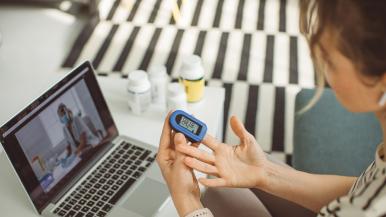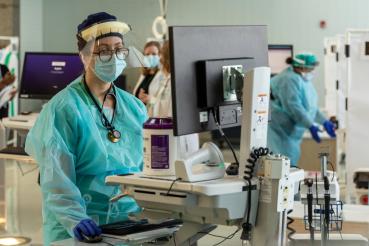Two easily measurable signs of health — respiration rate and blood-oxygen saturation — are distinctly predictive of higher mortality among patients hospitalized with COVID-19, according to a study examining the cases of inpatients with COVID-19 at Rush University Medical Center and University of Washington Medicine hospitals.
Notably, the study authors said, anyone who receives a positive COVID-19 screening test can easily monitor for these two signs at home to see if or when they need to seek urgent medical care.
This context is lacking in current guidance from the federal Centers for Disease Control and Prevention, which tells people with COVID-19 to seek medical attention when they experience overt symptoms such as “trouble breathing” and “persistent pain or pressure in the chest” — indications that may be absent even when respiration and blood oxygen have reached dangerously low levels, authors say.
Henry Huang, MD, a cardiologist at Rush University Medical Center who is affiliated with the study, said these findings suggest that by the time some people with COVID-19 feel bad enough to come to the hospital, a window for early medical intervention might have passed.
“We found that patients who presented to the hospital with hypoxemia (below 92% O2/oxygen saturation) or tachypnea (respiratory rate above 22 breaths per minute) had significantly lower in-hospital survival,” Huang explained. “Because not all patients who are hypoxic necessarily have symptoms, existing CDC guidelines should be recast to account for asymptomatic patients who are high risk.”
Researchers of the study examined the cases of 1,095 patients age 18 years and older who were admitted with COVID-19 to UW Medicine hospitals or Rush University Medical Center from March 1 to June 8, 2020. The lone exclusions were people who chose “comfort measures only” at time of their admission.
While patients frequently had hypoxemia (low blood-oxygen saturation; 91% or below for this study) or tachypnea (fast, shallow breathing that rises to 23 breaths per minute for this study), few reported feeling short of breath or coughing, regardless of blood oxygen levels.
The study's primary measure was all-cause in-hospital mortality. Overall, 197 of the patients included in the died in the hospital. Compared to those admitted with normal blood oxygen, hypoxemic patients had a mortality risk 1.8 to 4.0 times greater, depending on the patient’s blood oxygen levels.
Similarly, compared to patients admitted with normal respiratory rates, those with tachypnea had a mortality risk 1.9 to 3.2 times greater. In contrast, other clinical signs at admission, including temperature, heart rate and blood pressure, were not associated with mortality.
Nearly all patients with hypoxemia and tachypnea required supplemental oxygen, which, when paired with inflammation-reducing glucocorticoids, can effectively treat some acute cases of COVD-19.
The findings will have an impact on primary care and virtual care providers, who typically are the first-line clinical contacts for people who have received a positive COVID-19 test result and want to monitor meaningful symptoms.
Huang says the best way for people to monitor these sometimes-silent symptoms at home is to use portable pulse oximeter devices to monitor for a blood-oxygen level below 92%. These devices are readily available and inexpensive tools to monitor blood oxygenation levels and identify if a person needs to come to the hospital. If you don’t have access to a portable pulse oximeter, you also can check your respiration rate by counting the amount of times you breathe over the course of a minute.
If your blood-oxygen level falls below 92%, or your respirations rate rises to 22 to 23 breaths a minute, you should immediately call your doctor.





